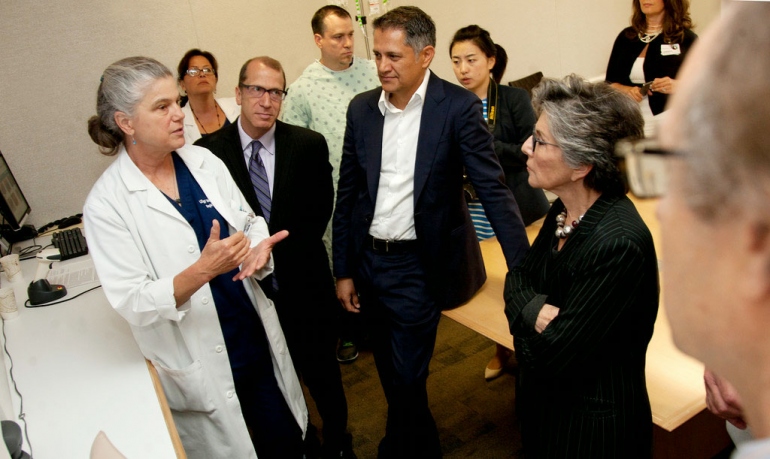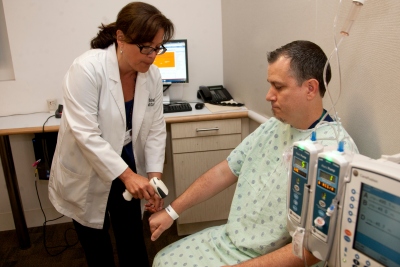Sen. Boxer Highlights Efforts to Reduce Preventable Hospital Deaths

California Sen. Barbara Boxer (second from right) tours UCSF Medical Center on July 2 to learn how it is working to reduce preventable deaths. Susan Barbour (left), RN, talks about pressure ulcer prevention.
Every year, between 210,000 and 440,000 Americans die as a result of preventable errors in hospitals, according to a special report released at UC San Francisco by Democratic Sen. Barbara Boxer.
She presented the updated report detailing the most common and harmful errors at our nation’s hospitals and highlighted what UCSF Medical Center is doing to prevent them.
“We have the opportunity to save not just one life, but to save hundreds of thousands of lives,” Senator Boxer said during her visit to UCSF Medical Center on July 2. “Many people will be shocked to hear this, but medical errors are one of the leading causes of death in America today. These deaths are all the more heartbreaking for families because they are preventable.”
Boxer said she is grateful to UCSF for the steps it has taken to save patients’ lives.

Hildy Schell-Chaple, RN, MS, demonstrates medication barcoding and dispensing at a tour with Senator Barbara Boxer at UCSF Medical Center.
“If we all work together – doctors, nurses, hospital administrators, patients, patient advocates, medical technology pioneers, public health experts and federal officials – we can prevent so much heartbreak for families and stop these tragedies before they occur,” said Boxer at a press conference following a tour of UCSF Medical Center.
Preventable errors in hospitals, such as hospital-acquired infections, adverse drug reactions, patient falls and bedsores, total $19.5 billion annually and that the economic costs of medical errors, including lost productivity, could be as much as $1 trillion a year, according to Boxer’s report.
“We’re one of the nation’s top hospitals,” said Mark R. Laret, CEO of UCSF Medical Center and UCSF Benioff Children’s Hospitals. “But that is meaningful only as it relates to every single patient who walks through our doors, and how we administer their care, follow up and safety. We’re proud of the great strides we’ve made as a leader in patient safety and to partner with Senator Boxer to help all hospitals become places where safe care is offered to every patient, every day.”
While touring UCSF Medical Center, Senator Boxer was shown the interdisciplinary approach UCSF takes to address major hospital issues such as sepsis, ulcer prevention, medication errors and hand hygiene.
As part of its interdisciplinary approach, UCSF creates teams comprised of nurses, pharmacists, doctors and medical center leaders, in addition to staff in medical records and environmental services. Those teams focus on understanding the underlying causes that may have allowed an error to occur and on collaborative problem solving. An open discussion ends with a clear action plan, which might involve implementing a new system, purchasing a piece of equipment, or training doctors and nurses in communication strategies.
UCSF Processes and Results for Sepsis Prevention
Sepsis is a potentially fatal, full-body inflammation caused by infection, and one of the main sources of sepsis is hospitals themselves.
“At UCSF we now treat sepsis as a true emergency with a focus on immediate interventions proven to help patients,” said Joshua Adler, MD, chief medical officer at UCSF Medical Center and UCSF Benioff Children’s Hospital San Francisco. “This approach has involved innovations in our electronic health record systems, use of rapid response personnel, novel nursing protocols, and continuous evaluation of our performance.”
UCSF’s electronic sepsis surveillance system continuously searches for warning signs, alerts clinicians to the potential presence of sepsis, and provides a means to activate “Code Sepsis”. The Code Sepsis team – a rapid response team, critical care nurse practitioner, and pharmacist – has helped UCSF to treat sepsis as an emergent situation requiring immediate attention and action. “With this approach we have reduced the mortality rate for sepsis by nearly 25 percent since 2012,” Adler said.
Processes and Results for Ulcer Prevention
Ulcers resulting from being bedridden, and thus immobile for a lengthy time, are an ongoing challenge for hospitals. In addition, to training all patient-care providers in pressure ulcer prevention, UCSF conducts quarterly pressure-ulcer prevalence study days. On these days, every patient in the hospital is examined for evidence of a pressure ulcer. The total number of pressure ulcers counted is divided by the total number of patients examined to obtain a percentage of patients with pressure ulcers.
UCSF has reduced the rate of hospital acquired pressure ulcers among adult and pediatric patients by 79 percent, from 4.98 percent in fiscal year 2008 to 1.03 percent in fiscal year 2014.
Preventing Inpatient Medication Errors
In 2011, UCSF launched what is believed to be the nation’s most comprehensive automated hospital robotic pharmacy that is designed to prepare and track medications, with the goal of improving patient safety. The pharmacy operation is now linked to the electronic health record system, creating an end-to-end electronic system in which a nurse at the bedside scans the barcode on the patient’s wristband, scans the medication and then scans the bar code on his/her own ID badge. Only after confirming all the information matches is the medication administered. UCSF administers over 10,000 doses of medication daily.
“The barcoding system is a way to minimize the potential for an error at every step of the medication delivery process,” said Laret.
Hand Hygiene Training and Surveillance
Hand hygiene is considered one of the most effective approaches for reducing hospital-related infections. In July 2010, UCSF implemented a hand hygiene education and surveillance program. Since then the rate of hand hygiene has improved from 75 percent to about 92 percent each month. The data are collected and monitored by cameras in some hospital areas, and a daily report is distributed. Some floors even feature real-time monitoring that displays hand hygiene compliance rates.
Photos by Cindy Chew